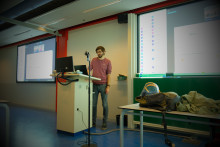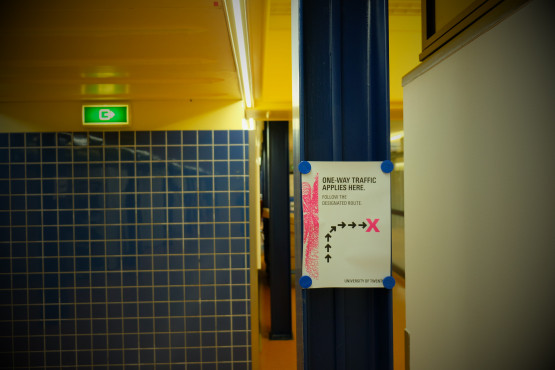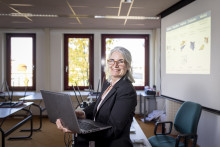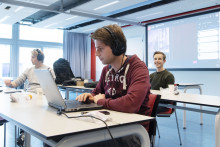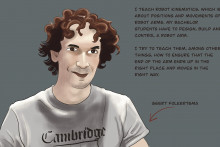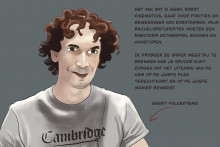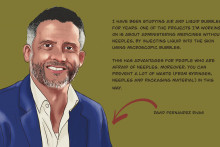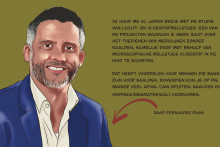‘How is the audio?’ Marcus Gerhold asks at the start of his lecture. A large screen next to the lecturer shows a chat box. ‘It's ASMR quality,' one of the people in the chat responds. Slowly the Creative Technology students arrive in lecture room Oosthorst 113. Today they are with about 25 people. In addition, another eighty students follow the lecture online. For them, a webcam is aimed at the lecturer and the lecture hall, so that the online students also get a bit of the classroom feeling. The tables at which the students sit are far apart from each other. If you want to move around, you put on a face mask. Corona attributes, such as hand gels and face shields, are ready to be used. This is the 'new normal' in the world of education.
Gerhold has prepared a lecture about ' Search Algorithms'. What are they and how do we use them? He explains it using the ghosts in Pacman. They 'search' for Pac-Man using an algorithm. While Gerhold further describes the subject, he regularly asks the students a question. Especially in the chat the students react eagerly to his inquiries. ‘Konrad, you're on fire,' says the teacher, when the online student gives the right answer for the second time.
Hybrid form
‘This went better than expected,’ Gerhold reacts somewhat relieved afterwards. ‘It was my first physical lecture since March.’ For the young teacher, the online tools hold few secrets. Everything works crescendo. Nevertheless, this hybrid form of teaching requires quite a lot of focus, Gerhold knows. ‘I try to actively involve the students in the chat, but then I sometimes lose my focus for the students in the lecture room. That's the tricky part.’
Afterwards, the students start working on their assignments. Laurens van Helvoort is one of the 'offline students'. The second year student is happy to be able to go to campus again occasionally. ‘At home, I notice that I’m less motivated. I regularly pick up my phone during lectures. Here, during physical meetings, I tend to focus much better. That's why I would like to have more physical meetings like this – although I understand that it's not always possible. Still, it’s actually quite strange that we are allowed to sit here with 25 people. Then again, in a setting like this, it’s possible.’
Emma Brouwer, a fourth-year Creative Technology student, has mixed feelings about the physical meetings. ‘I do miss the social aspect when I sit at home. That's why physical education is a positive thing. I'm also taking a minor in psychology. Everything goes online and I don't know anyone there yet. It's very awkward when you come into a video conversation, where all the psychology students already know each other and you're the new face. It's much easier to get to know each other offline. On the other hand, I’m trying to be very careful. I only speak to my family. Let's put it this way: if I were to catch the virus somewhere, I would run the biggest risk here. That's why I have mixed feelings about these classes. Fortunately, all the tables are neatly apart. I feel reasonably safe here.’
Risks
Gerhold is quite positive about the UT education policy in Covid times. ‘I’m from Germany myself and my friends tell me about German educational institutions where much less is allowed. That, of course, causes a considerable delay.’ Nevertheless, Gerhold is concerned about the risks of these physical meetings. ‘Especially if you're sitting in one room with two hundred people for an exam. Then again: I also have to take the train to Enschede. With a trip like that you also take a certain risk.’
The lecture is reaching its end. It was noticeable that the interaction between online and offline did not cause any problems today. In fact, the right answers usually appeared in the chat. Gerhold also noticed that. ‘Maybe the barrier to respond online is lower. In this instance, by the way, the chat is not anonymous. Larger online lectures usually are. That sometimes leads to strange situations. For example, I had a student at Computer Science who disturbed the conference with loud music. Well, of course I had to throw that student out.’


